
Being a plant parent is a rewarding experience, but it comes with its share of challenges. One of the most common mishaps we face is showering them with too much love, ehm, water. Overwatering is in fact one of the leading causes of plant death. So, today, we’re diving into the topic of overwatering—learning to identify the signs, rescuing your drowning plants, and mastering the art of prevention.
The Telltale Signs of Overwatering
Overwatering is like a sneaky villain that creeps up on our unsuspecting plants. Here are five clues to look out for:
- Wilting with Wet Soil: If your plant looks wilted despite the soil being wet, it might be suffering from overhydration. This is because the roots are suffocating in the soggy environment, depriving the plant of essential oxygen.
- Yellowing Leaves: Overwatering can lead to yellowing leaves, which is often mistaken as a sign of underwatering. Excessive moisture prevents the roots from absorbing nutrients, causing the leaves to lose their vibrant green hue.
- Mushy stems: If the base of the plant stem begins to feel mushy or unstable, you’ve overwatered. The soil can even begin to give off a rotten odor.
- Brown spots with a yellow halo: If the leaves develop brown spots or edges encircled by a yellow halo, that’s a bacteria infection due to overwatering.
- Mold and Fungus: An overly damp environment invites unwelcome guests like mold and fungus. Keep an eye out for fuzzy growth on the soil surface or around the base of the plant.
- Fungus Gnat: The presence of fungus gnats is also a common – but not always – sign of overwatering.






SOS: Rescuing Your Overwatered Plant
If you’ve detected the signs of overwatering, act fast! With some tender loving care, you can save your struggling plant. Follow these steps:
- Assess the Damage: If your plant is overwatered for an extended period, it may develop root rot. Gently lift the plant from its pot to inspect the roots. Healthy roots are firm and white, while rotten roots will be mushy and dark-colored. Trim away any mushy, rotten roots using clean scissors or pruning shears. Wash out the roots before repotting.
- Repot with Dry Soil: Choose a pot with good drainage. If you use the old one, make sure you wash it out thoroughly. Fill the bottom with fresh potting mix and place your plant on top. Surround it with dry soil, gently pressing down to remove air pockets.
- The Dry Spell: Give your plant a break from watering. Let the soil dry out completely before you water it again.
- Sunlight and Ventilation: Place your plant in a well-ventilated area with filtered sunlight. Avoid exposing it to direct sunlight immediately after repotting, as it may cause additional stress.
- Patience and Observation: Nursing your plant back to health takes time. Be patient and keep a close eye on it. New growth is a positive sign that your plant is on the road to recovery.
Preventing Overwatering: Mastering the Art
As the saying goes, „Prevention is better than cure.“ To keep your house plants happy and healthy, follow these tips to prevent overwatering:
- Know Your Plant: Different plants have different water needs. Research the specific requirements of each of your plant babies to avoid overwatering out of habit.
- Well-Draining Pots: Opt for pots with drainage holes. This allows excess water to escape, preventing waterlogged soil.
- Schedule Wisely: Don’t water on a strict schedule. Instead, water your plants when they need it. Plants need more water the brighter and warmer it is. So be careful with your watering routine during the colder seasons. Invest in a soil moisture meter. like our FYTA Beam, for accurate readings.
- Watering Techniques: When watering, do so slowly and evenly. Allow the water to soak through the soil gradually, preventing puddles at the surface.
- Use the Right Soil: Choose a high-quality, well-draining potting mix suitable for your plant’s needs.
Overwatering happens to the best of us, but now you’re armed with the knowledge to identify the signs, save your plants from drowning, and prevent future soggy drama.




Happy gardening! 🌿🌱






